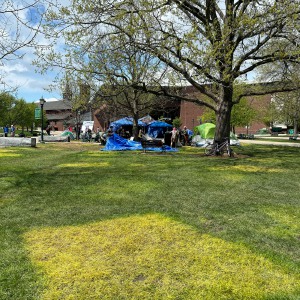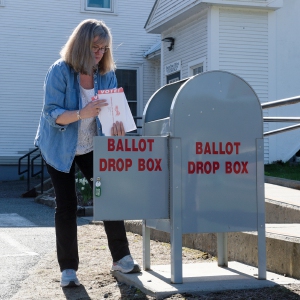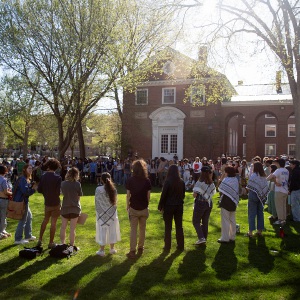Upper Valley Habitat tries new housing model with Weathersfield project
| Published: 05-08-2023 4:23 PM |
WEATHERSFIELD — Upper Valley Habitat for Humanity is proposing to build up to eight affordable housing units on Route 5 in Weathersfield.
The move marks a shift for the White River Junction-based nonprofit organization, which has historically focused on building single-family homes for lower income families.
“The project was really appealing to us because we’re starting to see this changing environment where we can no longer build a single family home affordably,” said Eva Loomis, Upper Valley Habitat’s executive director.
While the nonprofit has built duplexes in the past, it has not taken on a project of this scale.
The nonprofit purchased 2.2 acres of land and accompanying three buildings — an unoccupied duplex, cottage and restaurant — last fall for $175,000 from Deb Roberts and her son, Sean Roberts, said Loomis.
“Even though we will be building new on this property, we have the ability to renovate what is currently there also” she said.
At this time, the sale does not include the former grange hall, which until mid-2020 was the World Under Wonder Playhouse, which was operated by Sean Roberts.
The pair — along with Roberts’ daughter and real estate partner Jenna Luce — had reached out to Upper Valley Habitat late last summer to ask if the organization would be interested in purchasing the property, with the intention of building affordable housing.
Article continues after...
Yesterday's Most Read Articles
Deb and Sean Roberts purchased the property in 2017 for the grange hall, so that it could be connected to the same septic system as the rest of the buildings. Roberts said she spent $250,000 fixing up the grange, which had been vacant for around 15 years. She put the property on the market in 2021 for $399,000. Around a year later, Sean Roberts suggested they start looking at selling the property to a nonprofit organization committed to building affordable housing.
“This property is so amazing for Habitat,” said Roberts, a West Lebanon-based real estate agent. “I am so excited and so is Sean.”
The organization used to be able to build a home for around $200,000, and over the past few years, the cost was around $280,000.
“We’re able to build for less than (for-profit organizations and homebuilders) generally because we have in-kind donations and volunteers that help with labor,” Loomis said.
But even with those savings, the cost of materials has made it more difficult to build affordably.
In the past, the organization has focused on vacant parcels and new construction. The Weathersfield property has existing buildings that could be used for housing if modernized.
“Adaptive reuse projects — renovations — aren’t as appealing to contractors and builders because renovations are generally higher on the labor side,” Loomis said.
Because Upper Valley Habitat relies on volunteer labor, the cost savings from labor are magnified .
The Robertses will finance the sale, meaning the nonprofit organization will not have to go through a bank, Loomis said.
“I’m going to take the time to get my money because they’re a good program,” Roberts said. “That’s the most important thing.”
Before Upper Valley Habitat purchased the site, staff consulted with town officials to make sure their housing plan was in line with town zoning regulations.
“It’s a pretty blighted property, and I think that’s partially why the town has been so interested in this project,” Loomis said.
The building plans are still in the works and it is too soon to estimate how much it will cost, Loomis said. So far, the organization is planning on renovating the duplex, turning the cottage into a duplex and taking down the restaurant to put a triplex in its place. A single-family home built could also be added to the cluster.
“It’s a site that would be difficult to do much with and their vision is right in line with what our town plan lays out,” Land Use Administrator Ryan Gumbart said.
The Weathersfield Planning Commission approved the planned unit development sketch plan during a meeting last month. Upper Valley Habitat’s next stop is the Zoning Board of Adjustment, where it will ask for a variance on a 25-foot setback from Route 5, Gumbart said.
Then, the project will head back to the Planning Commission for final approval.
“Everything from the public that’s shown up at the meetings and the board has been positive and encouraging,” Gumbart said.
There are plans to put in a playground and community garden space for the residents.
The Exit 8 park and ride on Interstate 91 is about a mile away and is a stop for MOOver, a nonprofit transportation organization. Windham & Windsor Housing Trust will help Upper Valley Habitat recruit potential owners.
Roberts said part of the reason she wanted to work with Habitat is because of her work with younger, first-time homebuyers. Over her decades-long career, she has seen it become increasingly difficult for people starting out to buy homes.
She also is familiar with Habitat’s work and how much more expensive it has become for them to build homes. Roberts sees a lot of potential in renovating structures that already exist in the Upper Valley and remodeling them into workforce housing.
“There’s so many good things about it compared to buying a piece of land and having to put in a septic, put in a well, do site work,” Roberts said. “Those … plus the cost of the land can cost you $150,000 and you don’t even have a house yet.”
Part of the property’s appeal is that it is already connected to town water and has a septic system that can accommodate the project, Loomis said. In single-family home project, one owner would have been responsible for the cost of a system.
“In a multi-unit property those expensive costs can be distributed,” Loomis said.
Habitat sees the Weathersfield project as potentially the start of a focus on redeveloping blighted properties, abandoned homes and other “properties that might be unappealing to most people but still have value in them,” Loomis said.
“We see this as a pilot project in which we want to move in the direction of adaptive reuse and build in areas where there’s already existing community and infrastructure instead of creating more sprawl,” she added. “This is a different approach for us and we really hope that it’s one that can be replicated elsewhere.”
Liz Sauchelli can be reached at esauchelli@vnews.com or 603-727-3221.

 Students take down pro-Palestinian encampment at UVM
Students take down pro-Palestinian encampment at UVM Sharon voters turn back proposal to renovate school
Sharon voters turn back proposal to renovate school Dartmouth administration faces fierce criticism over protest arrests
Dartmouth administration faces fierce criticism over protest arrests
